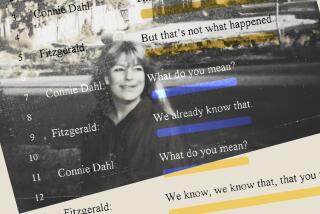Insurance Triangle : BLIND FAITH <i> by Joe McGinniss (G. P. Putnam’s Sons: $21.95; 381 pp.) </i>
- Share via
Got a few minutes to talk about the dregs of humanity? Author Joe McGinniss, who is developing a lurid specialty as a true crime writer--in “Blind Faith,” he writes, as he did in “Fatal Vision,” about a man accused of killing his wife--this time brings us a man who must have seen “Double Indemnity” too many times and, in his arrogance, decided he could play both the Fred MacMurray and Barbara Stanwyck roles. Insurance executive Rob Marshall takes his wife to an Atlantic City casino for dinner one night, and on the lonely drive home he pulls into a secluded rest area, ostensibly to check a thumping tire. Minutes later, he’s out cold on the ground and his wife, Maria, is dead, with two neat little bullet holes in the middle of her back.
Marshall’s explanation of what happened--that he and his wife were robbery victims--quickly starts to decay in the strong light of day. Lt. Bob Gladstone, the man in charge of homicide at the Ocean County, N.J., prosecutor’s office, keeps stumbling upon details that don’t jibe with the bereaved husband’s explanation: It seems that Rob Marshall, a man more ambitious than adept, left a very suspicious paper and telephone trail that meandered from the local high school where his lover worked, down to a hardware store in Shreveport, La., where all manner of lowlife hung out.
Gladstone’s theory, which became the foundation of the court case against Marshall, was that there were no robbers at the highway rest area. There were, he proposed, two hired killers (the busy modern executive delegates authority and pays a “shooter” instead of getting his hands dirty like MacMurray did), who only knocked Marshall out to throw investigators off the murder trail. The grieving husband was, in fact, an impatient Lothario who wanted to start life over with his new love--and with the $1.5 million he stood to receive from the life insurance policy he’d taken out on his wife. McGinniss has a theory, too, carefully laid in a subtext throughout “Blind Faith”: that Marshall, a speed demon on the boulevard of dreams, living in a boomtown suburb, was consumed by the prevalent greed. He looked at his wife and saw $1.5 million in assets if she died, and alimony and child support for their three sons if she lived and they got a divorce. He looked at Felice, his lover, and saw a fabulous piece of sexual real estate. So he made the prudent business decision.
The notion that the wages of yuppie sin is the death penalty has an amusing, perverse appeal for readers disaffected with gimme culture. And McGinniss rolls through this gilt-edged tragedy as smoothly as Marshall’s Cadillac pulled up to its final resting place. He is in charge of his material, which is to say, he can make sense out of nonsense without losing any of the suspense. Lt. Gladstone may be impatient about the “puzzle pieces” he’s missing; McGinniss, who holds all the pieces in his hand, manages to convey the investigators’ bewilderment without making the story line as confused as Gladstone is. The pacing of “Blind Faith” is just right. There is a sprung tension to it--a jittery mix of horror, apprehension and dead certainty--that makes the reader dread the conclusion just as he flips pages over faster to get to it.
Given his mastery of the form, it is a double shame that McGinniss did not take a few more chances with his storytelling. This is dry, sometimes hesitant prose, and McGinniss’ few attempts to inform the material with his sensibility, to remind us of the bankruptcy at the core of the Marshall family, often seem stilted, as though he knows he ought to give us more than just the facts, ma’am, but is reluctant to do so.
The unfortunate result is that Maria never emerges as anything more than a set of disparate anecdotal descriptions. McGinniss tells us that she was surpassingly beautiful, that one of the men allegedly involved in the shooting spied her sitting alone, holding a rose, and wondered how anyone could want her dead. We learn that she was a supermom who got up before her boys to make them breakfast and led the parental cheering section at swim meets. And we find out that there was tension between her and her husband.
But we get no help understanding these superficial reports. Maria Marshall should be such a vivid character that she rises up off the page and engages the reader’s sympathy. She doesn’t. All she does is raise frustrating questions about what lurked behind that perfectionist face.
It is impossible to avoid the obvious comparison to the late Thomas Thompson’s classic “Blood and Money,” the tale of a Texas doctor accused of murdering his socialite wife, which was a heady tapestry of detail and vibrant characterizations; even the bit players in that book were as sharp as photographs, and his sense of place was so finely tuned that he could make the very trees seem like co-conspirators. Had McGinniss been able to tell us more--and the role of the crime writer is not just to re-create, but to inform his re-creation with emotional resonances--”Blind Faith” could have been, like “Blood and Money,” an enduring work of literature that happened to center on a crime. Without that component, “Blind Faith” belligerently refuses to budge from the ranks of the commercial, well-crafted procedural.
More to Read
Sign up for Essential California
The most important California stories and recommendations in your inbox every morning.
You may occasionally receive promotional content from the Los Angeles Times.










